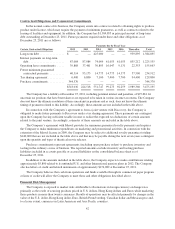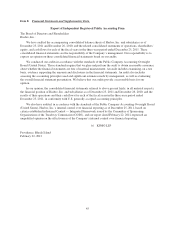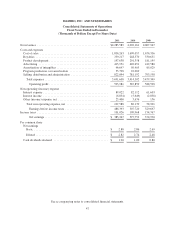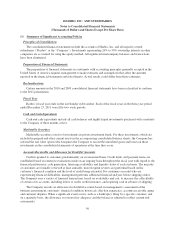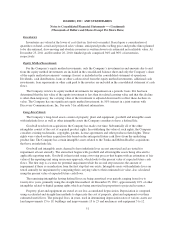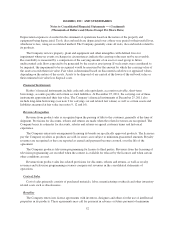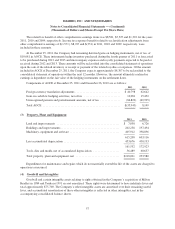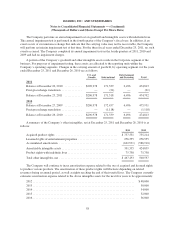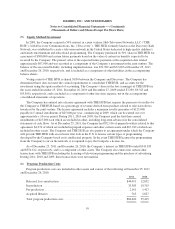Hasbro 2011 Annual Report Download - page 61
Download and view the complete annual report
Please find page 61 of the 2011 Hasbro annual report below. You can navigate through the pages in the report by either clicking on the pages listed below, or by using the keyword search tool below to find specific information within the annual report.
HASBRO, INC. AND SUBSIDIARIES
Notes to Consolidated Financial Statements — (Continued)
(Thousands of Dollars and Shares Except Per Share Data)
Depreciation expense is classified in the statement of operations based on the nature of the property and
equipment being depreciated. Tools, dies and molds are depreciated over a three-year period or their useful lives,
whichever is less, using an accelerated method. The Company generally owns all tools, dies and molds related to
its products.
The Company reviews property, plant and equipment and other intangibles with defined lives for
impairment whenever events or changes in circumstances indicate the carrying value may not be recoverable.
Recoverability is measured by a comparison of the carrying amount of an asset or asset group to future
undiscounted cash flows expected to be generated by the asset or asset group. If such assets were considered to
be impaired, the impairment to be recognized would be measured by the amount by which the carrying value of
the assets exceeds their fair value. Fair value is determined based on discounted cash flows or appraised values,
depending on the nature of the assets. Assets to be disposed of are carried at the lower of the net book value or
their estimated fair value less disposal costs.
Financial Instruments
Hasbro’s financial instruments include cash and cash equivalents, accounts receivable, short-term
borrowings, accounts payable and certain accrued liabilities. At December 25, 2011, the carrying cost of these
instruments approximated their fair value. The Company’s financial instruments at December 25, 2011 also
include long-term borrowings (see note 9 for carrying cost and related fair values) as well as certain assets and
liabilities measured at fair value (see notes 9, 12 and 16).
Revenue Recognition
Revenue from product sales is recognized upon the passing of title to the customer, generally at the time of
shipment. Provisions for discounts, rebates and returns are made when the related revenues are recognized. The
Company bases its estimates for discounts, rebates and returns on agreed customer terms and historical
experience.
The Company enters into arrangements licensing its brands on specifically approved products. The licensees
pay the Company royalties as products are sold, in some cases subject to minimum guaranteed amounts. Royalty
revenues are recognized as they are reported as earned and payment becomes assured, over the life of the
agreement.
The Company produces television programming for license to third parties. Revenues from the licensing of
television programming are recorded when the content is available for telecast by the licensee and when certain
other conditions are met.
Revenue from product sales less related provisions for discounts, rebates and returns, as well as royalty
revenues and television programming revenues comprise net revenues in the consolidated statements of
operations.
Costs of Sales
Cost of sales primarily consists of purchased materials, labor, manufacturing overheads and other inventory-
related costs such as obsolescence.
Royalties
The Company enters into license agreements with inventors, designers and others for the use of intellectual
properties in its products. These agreements may call for payment in advance or future payment of minimum
52


